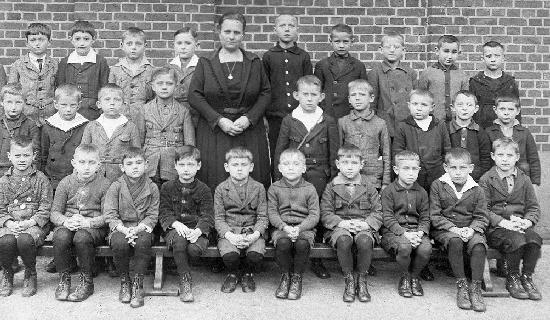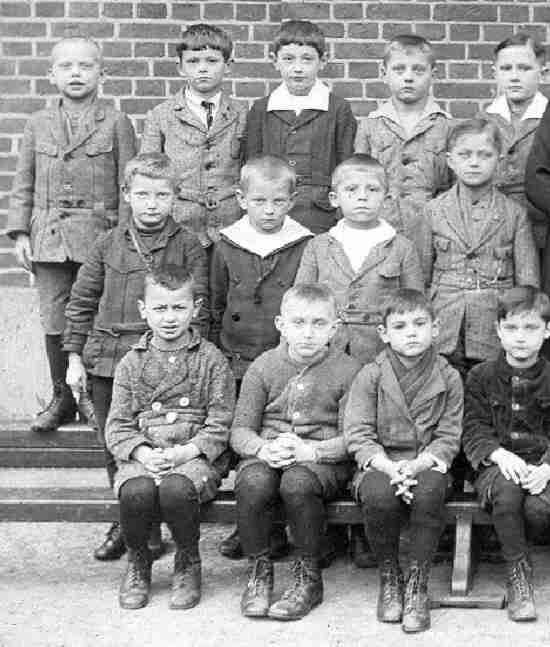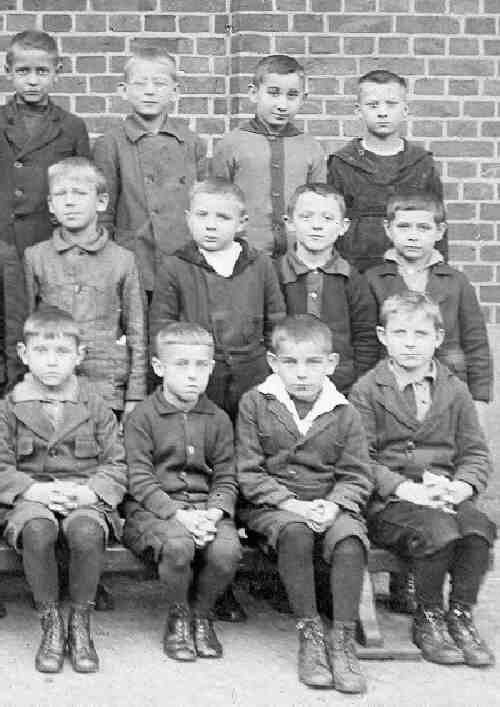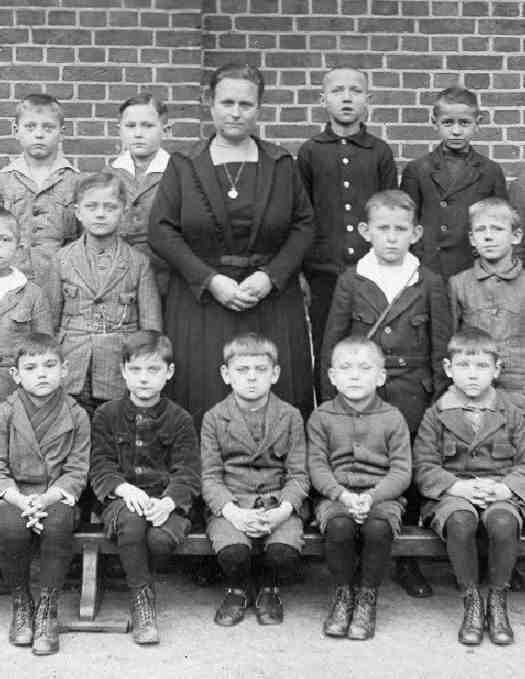
Figure 1.--The boys wear a wide range of outfits from suits to sweaters and scarves. All of the boys, however, wear knepants and dark long stockings..


Figure 1.--The boys wear a wide range of outfits from suits to sweaters and scarves. All of the boys, however, wear knepants and dark long stockings.. |
This looks to HBC to be a German primary class photographed in the late 1910s. The early 1920s is a possibility, but the late 1910s
looks more likely. The boys wear a wide range of outfits from suits to sweaters and scarves. All of the boys, however, wear knepants and dark long stockings.
The children look to have been photographed in front of a large brick building. This suggests to HBC that the school was a large inner-city school.
The children look to be quite young. HBC would believe that this is either the first or second year class in the school. Note that the teacher is a lady. A lot of German primary chool teacher were men. This is one of the factors suggesting that this may be a photograph taken during World War I when so many men were called up for military service. There is considrable difference in the clothing the children wear, suggesting that boys attended from families of varied family background.

Figure 2.--Notice only one boy here wears a tie and that several boys have open collar shirts. There is also only one boy wearing a sailor suit. |
The children look to be about 6-7 years of age.
This photograph is undated. We believe that the photograph was taken in the later part of World war I, probably about 1918. The fact that the children wear kneepants and dark long stockings rather than shorts and kneesocks. Some of the children are wearing older looking clothes, perhaps reflecting deteriorating conditions in the last year of the War. The fact that they have a lady teacher also suggests it may have been a War-time portrait.
None of the boys wear their caps.
As might be be expected from a German school, none of the boys wear smocks.
Sailor suits were very popular for German boys. We only notice one of these boys, however, wearing a sailor suit. Another boy at the far right on the back row may also be wearing a very plain dark sailor suit, but it is hard to tell. We would have thought sailor suits would have been more popular--especillly with boys of this age group. We wonfer if there were regional or demographic differences in the popularity od sailor suits.
Many of the boys wear suits, some with ties and some with open collars. Many of the suits have belts or other features that look rather like Norfolk jackets.

Figure 3.--These boys wear a wide variety of clothes. Some wear suit coats, but without ties. Most boys have buttoned their collar buttons, but not all. Again several boys have close cropped hair and three boys have bangs. |
We obly see one boy wearing a tie.
Some of the boys wear sweaters instead of suits. Some of the sweaters look beaten up. The sweaters all seem to be solis colors. I do not note any fabcy sweaters with colors.
Several boys wear jackets that button at the collar rather than suit coats. It is not clear to HBC what was worn unfer the jackets that were buttoned at the collar.
The boys wear a variety of shirts. As the boys wear jackets and sweaters, its hard to see much of the shirts. They all appear to be solid colors. One noticeable aspect of the shirts is the collars, some of which the boys wear outside of their jackets. A few boys wear shirts with the collar and front pannel in a different contrasting color than the rest of the shirt. Note that none of the boys have Eton collars.
All of the boys appear to be wearing kneepants. I do not note any knickers or short pants or for that matter long pants. We can not tell for all of the boys, but the onec in front are all wearing kneepants.
All of the children wear long dark stockings. Although it is a little difficult to tell, we do not notice any of the light-colored brown or tan stockings that became popular in the 1920s.
All of the boys wear hightop boot-like shoes. Only one boy wears strap sandals.
A few of the boys have quite short hair cuts, some eben shaved heads. Most boys have hort, but not close-cropped hair.

Figure 4.--The boys all seem to be wearing similar hightop boot-like shoes. The only exceoption is one boy wearing strap sandals. |
Related Chronolgy Pages in the Boys' Historical Web Site
[Main Chronology Page]
[The 1880s]
[The 1890s]
[The 1900s]
[The 1910s]
[The 1920s]
[The 1930s]
[The 1940s]
[The 1950s]
[The 1960s]
[The 1970s]
[The 1980s]
[The 1990s]
Navigate the German school pages
[Return to the Main individual German school page]
[Return to the Main German 1910s page]
[Return to the Main German school uniform page]
[Imperial Germany]
[Weimar Republic]
[NAZI era]
[Post-war Years]
[Modern Germany]
Navigate the Boys' Historical Clothing Web Page
[Introduction]
[Activities]
[Biographies]
[Bibliographies]
[Chronology]
[Clothing styles]
[Countries]
[Contributions]
[FAQs]
[German glossary]
[Satellite sites]
[Boys' Clothing Home]
